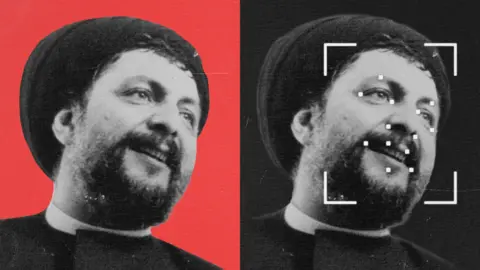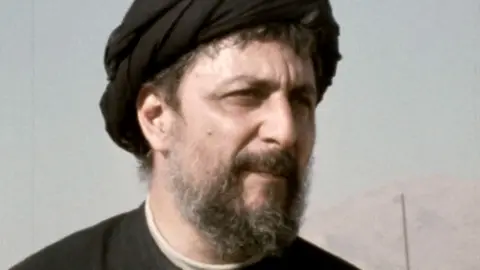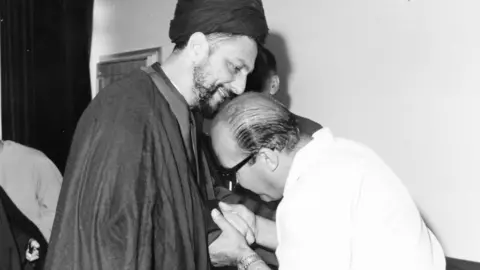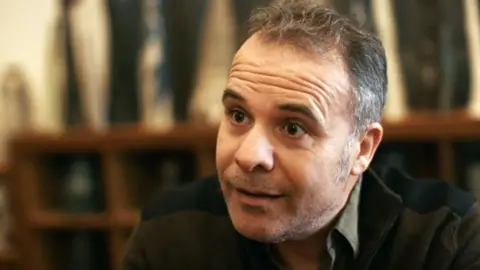Moe ShreifBBC Eye Investigations
 BBC
BBCWarning: Contains images some may find upsetting
A computer scientist at a university in the north of England is studying an image of a corpse – attempting to solve a mystery that has gripped the Middle East for nearly 50 years.
“This is what he looks like now?” asks Bradford University’s Prof Hassan Ugail doubtfully.
The digitised photo is of a decomposed face and it is about to be run through a special algorithm for our BBC investigation.
The original photo was taken by a journalist who saw the body in a secret mortuary in the Libyan capital in 2011. He was told then that it could be charismatic cleric Musa al-Sadr, who vanished in Libya in 1978.
Sadr’s disappearance has spawned endless conspiracy theories. Some people believe he was killed, while others claim he is still alive and being held somewhere in Libya.
For his ardent followers, his disappearance holds the same level of intrigue as the 1963 killing of US President John F Kennedy. Such is the sensitivity of our long investigation that my BBC World Service team and I even found ourselves detained in Libya for several days.
Emotions run high because Sadr is so revered by his followers – both for his political reputation, having advocated on behalf of his native Lebanon’s then-marginalised Shia Muslims, and as a wider religious leader.
His followers gave him the title of imam, an unusual honour for a living Shia cleric and one bestowed on him in recognition of his work on behalf of the Shia community.
His mysterious disappearance has added to his emotional power because it echoes the fate – according to the largest branch of Shia Islam, known as Twelvers – of the “hidden” 12th imam, who disappeared in the 9th Century. Twelver Muslims believe the 12th imam did not die and will return at the end of time to bring justice to Earth.
And Sadr’s disappearance also arguably changed the fate of the world’s most politically, religiously and ethnically volatile region – the Middle East. Some believe the Iranian-Lebanese cleric was on the verge of using his influence to take Iran – and, as a result, the region – in a more moderate direction when he disappeared on the eve of the Iranian revolution.
So there was a lot riding on Bradford University’s identification efforts. The journalist who took the photo told us the body was unusually tall – and Sadr was said to be 1.98m (6ft 5in). But the face had barely any identifiable features.
Could we finally solve the mystery?
 Imam Sadr Foundation
Imam Sadr FoundationI am from the village of Yammouneh, high in the mountains of Lebanon, where stories have long been told of the terrible winter of 1968 when, after the community was devastated by an avalanche, Musa al-Sadr waded through deep snow to come to the village’s aid.
The wonder with which the villagers share this story today reflects just how mythologised he has become. One told me, referring to his memories as a four-year-old: “It was like a dream… He walked across the snow, followed by all the villagers… I followed him just to touch the Imam’s robe.”
Back in 1968, Sadr wasn’t well known in an isolated village like Yammouneh, but he was slowly garnering a national reputation. By the end of that decade he had become a major figure in Lebanon, known for advocating for interfaith dialogue and national unity.
His status was reflected in the honorary title “imam” bestowed on him by his followers. In 1974, Sadr launched the Movement of the Deprived, a social and political organisation which called for proportional representation for the Shia and social and economic emancipation for the poor, regardless of their religion. So determined was he to avoid sectarianism that he even gave sermons in Christian churches.
 Imam Sadr Foundation
Imam Sadr FoundationOn 25 August 1978, Sadr flew to Libya, invited to meet the country’s then leader Colonel Muammar Gaddafi.
Three years earlier, Lebanon had erupted into civil war. Palestinian fighters became involved in the sectarian conflict, with many based in Lebanon’s south, where most of Sadr’s followers lived. The Palestinians had begun exchanging fire with Israel across the border, and Sadr wanted Gaddafi, who supported the Palestinians, to intervene to keep Lebanon’s civilians safe.
On 31 August, after six days spent waiting for a meeting with Gaddafi, Sadr was seen being driven away from a Tripoli hotel in a Libyan government car.
He was never seen again.
Gaddafi’s security forces later claimed he had left for Rome, though this was proved false by the investigations that followed.
Independent journalism was impossible in Gaddafi’s Libya. But in 2011, when Libyans rose against him during the Arab Spring, the door of probity opened a crack.
Kassem Hamadé, a Lebanese-Swedish reporter who covered the uprising, was told about a secret mortuary in Tripoli that, a source had said, might contain the remains of Sadr.










